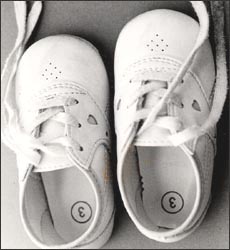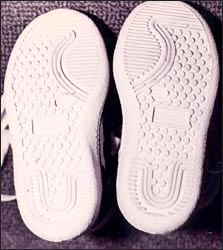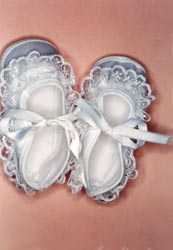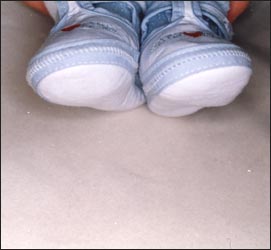아이들의 신발, Children shoes
- 갓 태어난 신생아들이 병원 신생아실에서 퇴원해 집으로 갈 때 그들에게 신발을 신겨준다.
- 아직 서고 걸을 수 없는 어린 영아들에게도 신발을 신겨준다.
- 신생아들이나 영유아들에게 신발을 신기는 것은 잘못은 아니다.
- 어떤 신발은 어린 영유아들의 발 성작발육에 때로는 해로울 수 있다.
- 영유아들이나 학령기 아이들에게 신발을 사줄 때 참고 할 사항을 알아보자

사진 84. 영유아들의 신발
발과 발가락이 꼭 끼지 않는 신발이 좋다
신발의 앞 부위가 괙 조이지 않고 넉넉한 크기 신발이 더 좋다.
신발 안 속과 바깥 사이로 공기가 유통될 수 있게 신발의 등에 구멍이 있으면 더 좋다.
Copyright ⓒ 2011 John Sangwon Lee, M.D., FAAP

사진 85. 영유아들의 신발
사진 신발에서 볼 수 있는 것과 같이 신발의 앞 부분와 뒷 부분을 한손으로 잡고 신발을 꾸부릴 때 신발이 쉽게 구부러질 수 있을 정도로 부드러운 신발이 더 좋다.
Copyright ⓒ 2011 John Sangwon Lee, M.D., FAAP

사진 86. 영유아들의 신발
값이 싸고 부드러운 신발이 좋다.
Copyright ⓒ 2011 John Sangwon Lee, M.D., FAAP

사진 87. 영유아들의 신발 바닥
미끄러지지 않게 신발 바닥이 두둘두둘한 것이 더 좋다.
Copyright ⓒ 2011 John Sangwon Lee, M.D., FAAP

사진 88. 신으면 편안한 신발이 더 좋다.
발이 점차로 커짐에 따라 발 크기에 알맞은 신발로 바꿔 신겨야 한다.
Copyright ⓒ 2011 John Sangwon Lee, M.D., FAAP

사진 89. 발가락이 조이지 않게 신발의 앞부분이 넉넉히 커야한다.
Copyright ⓒ 2011 John Sangwon Lee, M.D., FAAP
신발 신는 목적과 신발 살 때 고려할 점
- 발에 열상 자상 등 외상이 생기지 않게 발을 보호하기 위해
- 발을 따뜻하게 보호하고 발이 차지 않게 보호하기 위해
- 발을 예쁘게 보이게
- 더러운 오물이 발에 묻지 않게
- 세균이 감염되지 않게
- 발을 청결하게 하기 위해
- ‘발에 더러운 것이 묻지 않고, 상처가 발에 날 염려가 없으면 신발을 신지 않고 맨발로 걷는 것이 발 건강에 가장 좋다.’라는 말이 있다.
- 발 크기에 맞지 않고 발 건강에 도움이 되지 않는 신발은 발을 불편하게 할뿐만 아니라 티눈, 족통 등 여러 종류의 발병을 일으킬 수 있다.
- 특히 영유아들, 학령기 아이들의 발은 매일매일 계속 무럭무럭 자라고 크기 때문에 그들의 발의 크기에 따라 더 큰 신발로 자주 바꾸어 신어야 한다.
- 부모들은 자녀들의 신발이 발 크기에 적절한지 자주 체크해야 한다.
- 신발이 다 떨어지지 않아도 새신으로 필요에 따라 바꿔 주어야 한다.
- 아이들에게 새 신발을 사 줄 때는 참고사항을 고려해야 한다.
서고 걷기 전 영아들에게 신발을 사줄 때
- 가능한 한 값이 저렴하고,
- 발을 따뜻하고 춥지 않게 보호해 줄 수 있고,
- 보기에도 좋고 발에 편안한 신발이면 적절한 신발이라고 할 수 있다.
타들어 유아들, 학령기 전 유아들, 학령기 아이들에게 신발을 사 줄 때
- 신발의 크기가 발의 크기보다 조금 더 크고 폭이 넉넉히 크고,
- 신고 서 있을 때 엄지발가락 맨 끝에서 신발의 맨 앞부분 안쪽까지 1~2㎝ 정도 빈 공간이 있어야 하고,
- 발가락들이 서로 겹치지 않고 꼭 끼지 않도록 신발 앞 좌우 폭이 넓어야 한다.
- 신발은 뻣뻣하지 않고 부드러워야 하고,
- 신발 안 쪽 바닥까지 공기가 잘 유통될 수 있도록 신발의 등에 구멍이 적어도 몇 개 정도 뚫려있는 신발이 발 건강에 좋다.
- “어린 영유아들 신발은 발목까지 올라올 수 있어야 발목과 발이 더 튼튼하게 더 잘 성장 발육할 수 있다”고 주장하는 사람도 있다. 그러나 의학적 근거가 없는 말이다.
- 특히 영유아들, 학령기 아이들이 발이나 발목에 꼭 끼는 신발을 오랫동안 신으면 발이나 발목이 정상적으로 성장 발육하는 데 지장이 생길 수 있고 더 불편을 느낄 수 있다.
Children’s shoes
• Put on shoes for newborns as they go home from the hospital neonatal unit.
• Provide shoes for young infants who are not yet able to stand or walk.
• It is not wrong to wear shoes to newborns or young children.
• Certain footwear can sometimes be detrimental to the development of the feet in young children.
• Find out what to keep in mind when buying shoes for toddlers and school-age children.

Photo 84. Shoes for infants and toddlers Shoes that don’t fit your feet and toes are good. It is better to have a loose-fitting shoe without the front part of the shoe being tight. It would be better if there were holes in the back of the shoe to allow air to circulate between the inside and outside of the shoe. Copyright ⓒ 2011 John Sangwon Lee, M.D., FAAP

Photo 85. Shoes for infants and toddlers A shoe that is soft enough to bend easily when bending the shoe while holding the front and back of the shoe with one hand, as you can see in the photo shoe, is better. Copyright ⓒ 2011 John Sangwon Lee, M.D., FAAP

Photo 86. Shoes for infants and toddlers Cheap and soft shoes are good. Copyright ⓒ 2011 John Sangwon Lee, M.D., FAAP

Photo 87. Soles of infants and toddlers It is better if the soles of the shoes are thick so that they do not slip. Copyright ⓒ 2011 John Sangwon Lee, M.D., FAAP

Photo 88. Comfortable shoes are better. As your feet grow larger, you will need to change to a shoe that is appropriate for your foot size. Copyright ⓒ 2011 John Sangwon Lee, M.D., FAAP

Photo 89. The front of the shoe should be large enough so that the toes are not tightened. Copyright ⓒ 2011 John Sangwon Lee, M.D., FAAP
What to wear and what to consider when buying shoes
• To protect your feet from injuries such as lacerations, cuts, etc.
• To keep your feet warm and protect them from getting cold.
• Make your feet look pretty
• Do not let dirty dirt get on your feet.
• To prevent bacterial infection
• To keep your feet clean
• There is a saying that ‘It is best to walk barefoot without shoes as long as there is no dirt on your feet and there is no risk of getting injured on your feet.’
• Shoes that do not fit the size of your feet and are not conducive to foot health not only make your feet uncomfortable, but can also cause various types of diseases such as corns and foot pain.
• Especially, the feet of infants and children of school age continue to grow and grow every day, so it is necessary to change to a bigger shoe frequently according to the size of their feet.
• Parents should frequently check that their children’s shoes are appropriate for the size of their feet.
• Even if the shoes run out, they should be replaced with new ones as needed.
• When buying a new pair of shoes for your children, you should consider a note. When buying shoes for infants before standing and walking • as cheap as possible;
• can keep your feet warm and cold,
• Shoes that look good and are comfortable for your feet are appropriate. When buying shoes for burnt infants, pre-school children, and school-age children
• The size of the shoe is slightly larger than the size of the foot and wide enough;
• When standing, there should be an empty space of 1~2cm from the tip of the big toe to the inside of the front of the shoe.
• The width of the front and left sides of the shoe should be wide so that the toes do not overlap each other and do not fit tightly.
• Shoes should be soft and not stiff;
• Shoes with at least a few holes in the back of the shoe to allow air to circulate well to the bottom of the shoe are good for foot health.
• Some claim that “shoes for infants and toddlers need to be able to go up to the ankle so that their ankles and feet can grow stronger and develop better.” But it has no medical basis.
• If infants or school-age children wear shoes that fit their feet or ankles for a long time, it may interfere with the normal growth and development of their feet or ankles and may make them feel more uncomfortable.
출처 및 참조 문헌 Sources and references
- NelsonTextbook of Pediatrics 22ND Ed
- The Harriet Lane Handbook 22ND Ed
- Growth and development of the children
- Red Book 32nd Ed 2021-2024
- Neonatal Resuscitation, American Academy Pediatrics
- www.drleepediatrics.com 제1권 소아청소년 응급 의료
- www.drleepediatrics.com 제2권 소아청소년 예방
- www.drleepediatrics.com 제3권 소아청소년 성장 발육 육아
- www.drleepediatrics.com 제4권 모유,모유수유, 이유
- www.drleepediatrics.com 제5권 인공영양, 우유, 이유식, 비타민, 미네랄, 단백질, 탄수화물, 지방
- www.drleepediatrics.com 제6권 신생아 성장 발육 육아 질병
- www.drleepediatrics.com제7권 소아청소년 감염병
- www.drleepediatrics.com제8권 소아청소년 호흡기 질환
- www.drleepediatrics.com제9권 소아청소년 소화기 질환
- www.drleepediatrics.com제10권. 소아청소년 신장 비뇨 생식기 질환
- www.drleepediatrics.com제11권. 소아청소년 심장 혈관계 질환
- www.drleepediatrics.com제12권. 소아청소년 신경 정신 질환, 행동 수면 문제
- www.drleepediatrics.com제13권. 소아청소년 혈액, 림프, 종양 질환
- www.drleepediatrics.com제14권. 소아청소년 내분비, 유전, 염색체, 대사, 희귀병
- www.drleepediatrics.com제15권. 소아청소년 알레르기, 자가 면역질환
- www.drleepediatrics.com제16권. 소아청소년 정형외과 질환
- www.drleepediatrics.com제17권. 소아청소년 피부 질환
- www.drleepediatrics.com제18권. 소아청소년 이비인후(귀 코 인두 후두) 질환
- www.drleepediatrics.com제19권. 소아청소년 안과 (눈)질환
- www.drleepediatrics.com 제20권 소아청소년 이 (치아)질환
- www.drleepediatrics.com 제21권 소아청소년 가정 학교 간호
- www.drleepediatrics.com 제22권 아들 딸 이렇게 사랑해 키우세요
- www.drleepediatrics.com 제23권 사춘기 아이들의 성장 발육 질병
- www.drleepediatrics.com 제24권 소아청소년 성교육
- www.drleepediatrics.com 제25권 임신, 분만, 출산, 신생아 돌보기
- Red book 29th-31st edition 2021
- Nelson Text Book of Pediatrics 19th- 21st Edition
- The Johns Hopkins Hospital, The Harriet Lane Handbook, 22nd edition
- 응급환자관리 정담미디어
- Pediatric Nutritional Handbook American Academy of Pediatrics
- 소아가정간호백과–부모도 반의사가 되어야 한다, 이상원 저
- The pregnancy Bible. By Joan stone, MD. Keith Eddleman, MD
- Neonatology Jeffrey J. Pomerance, C. Joan Richardson
- Preparation for Birth. Beverly Savage and Dianna Smith
- 임신에서 신생아 돌보기까지. 이상원
- Breastfeeding. by Ruth Lawrence and Robert Lawrence
- Sources and references on Growth, Development, Cares, and Diseases of Newborn Infants
- Emergency Medical Service for Children, By Ross Lab. May 1989. p.10
- Emergency care, Harvey Grant and Robert Murray
- Emergency Care Transportation of Sick and Injured American Academy of Orthopaedic Surgeons
- Emergency Pediatrics A Guide to Ambulatory Care, Roger M. Barkin, Peter Rosen
- Quick Reference To Pediatric Emergencies, Delmer J. Pascoe, M.D., Moses Grossman, M.D. with 26 contributors
- Neonatal resuscitation American academy of pediatrics
- Pediatric Nutritional Handbook American Academy of Pediatrics
- Pediatric Resuscitation Pediatric Clinics of North America, Stephen M. Schexnayder, M.D.
-
Pediatric Critical Care, Pediatric Clinics of North America, James P. Orlowski, M.D.
-
Preparation for Birth. Beverly Savage and Dianna Smith
-
Infectious disease of children, Saul Krugman, Samuel L Katz, Ann A.
- 제4권 모유, 모유수유, 이유 참조문헌 및 출처
- 제5권 인공영양, 우유, 이유, 비타민, 단백질, 지방 탄수 화물 참조문헌 및 출처
- 제6권 신생아 성장발육 양호 질병 참조문헌 및 출처
- 소아과학 대한교과서
Copyright ⓒ 2014 John Sangwon Lee, MD., FAAP
“부모도 반의사가 되어야 한다”-내용은 여러분들의 의사로부터 얻은 정보와 진료를 대신할 수 없습니다.
“The information contained in this publication should not be used as a substitute for the medical care and advice of your doctor. There may be variations in treatment that your doctor may recommend based on individual facts and circumstances.
“Parental education is the best medicine.